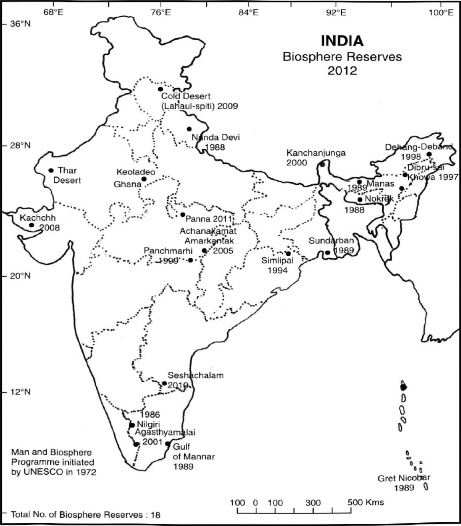Biosphere Reserves
Biosphere reserves are areas of terrestrial and coastal ecosystems which are internationally recognised within the framework of UNESCO's 'Man and Biosphere (MAB) Programme'. These reserves are required to meet a minimal set of criteria and adhere to a minimal set of conditions before being admitted to the World Network of Biosphere Reserves designated by the UNESCO. These reserves are rich in biological and cultural diversity and encompass unique features of exceptionally pristine nature. The scheme is a pioneering effort at pursuing the increasing difficult yet urgent task of conserving ecological diversity under mounting pressures.
The main objectives for the delineation of biosphere reserves are:
1. To conserve biological and cultural diversity and integrity of plants animals, birds, reptiles, micro-organisms and unique features of pristine nature.
2. To promote research on ecological conservation and other environmental aspects, and
3. To provide facilities for education, research, awareness and training.
The Biosphere Reserves Programme was initiated in India in 1986 and till date, 18 sites have been designated as Biosphere Reseives (BR) in different parts of the country. The names of the biosphere reserves of India have been given in Table 5.1 and their locations have been shown in Fig. 5.7.
Tab Ie 5.5 Biosphere Reserves of India
Biosphere Reserve | Geographical Area in sq km | Slates | |
1. | Nilgiri | 5520 | Tamil Nadu, Kerala, Karnataka |
2. | Nanada Devi | 5861 | Uttarkhand |
3. | Nokrek | 0820 | Meghalaya |
4. | Manas | 2837 | Assam |
5. | Sundarban | 9630 | West Bengal |
6. | Gulf of Mannar | 10,500 | Tamil Nadu coast |
7. | Great Nicobar | 0885 | Andaman and Nicobar Islands |
8. | Simlipal | 4,374 | Odisha |
9. | Dibru-Saikhowa | 0765 | Arunachal Pradesh |
10. | Dehang-Debang | 0512 | Arunachal Pradesh |
11. | Kangchendzonga | 2620 | Sikkim (Kanchenjunga) |
12. | Panchmarhi | 4928 | Madhya Pradesh |
13. | Agasthymalai | 3500 | Kerala |
14. | Achanakmar Amarkantak | 38351 | Madhya Pradesh |
15. | Kachchh | 12,454 | Gujarat |
16. | Cold Desert | 7555 | Lahaul-Spiti and ladakh |
17. | Sheshachalam | 4500 | Andhra Pradesh |
18. | Panna Total | 4100 1,19,712 | Madhya Pradesh |
The programme was initiated in 1986 and till date, 18 sites have been designated as Biosphere Reserves in different parts of the country. Out of the 18 biosphere reserves, seven biosphere reserves have been included in the World Network of Biosphere Reserves so far. These 7 include: Sundarban, Gulf of Mannar, Nilgiri, Nanda Devi, l’anchmarhi, Simlipal and Nokrek.
These biosphere reserves include:
1. Nilgiri, 2. Nokrek, 3. Nanda Devi, 4. Sundraban, 5. Gulf of Mannar, 6. Manas, 7. Great Nicobar, 8. Simlipal, 9. Dibru Saikhova, 10. Dehang Dibang,
11. Panchmarhi, 12. Kanchanjunga, 13. Agasthamalai, 14. Achanakamar, 15. Great Rann of Kachchh, 16. Cold Desert (Pin-Valley-II.P.), 17. Seshachalam (Andhra Pradesh), 18. Panna (M.P.), Seven out of the 18 biosphere reserves are a part of the World Network of Biosphere Reserves based on the UNESCO Man and Biosphere Programme List. Their names are: 1. Nilgirj 2 Sundarban, 3. Gulf of Mannar, 4. Nanda Devi, 5. Kokrek, 6. Panchmarhi, and 7. Simplipaj

